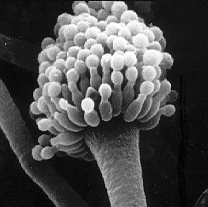
Penicillium is a genus of ascomycetous fungi that is part of the mycobiome of many species and is of major importance in the natural environment, in food spoilage, and in food and drug production.

Partitiviridae is a family of double-stranded RNA viruses. Plants, fungi, and protozoa serve as natural hosts. It has been suggested that they can also infect bacteria. The name comes from the Latin partitius, which means divided, and refers to the segmented genome of partitiviruses. There are five genera and 60 species in the family, 15 of which are unassigned to a genus.

The fungi imperfecti or imperfect fungi are fungi which do not fit into the commonly established taxonomic classifications of fungi that are based on biological species concepts or morphological characteristics of sexual structures because their sexual form of reproduction has never been observed. They are known as imperfect fungi because only their asexual and vegetative phases are known. They have asexual form of reproduction, meaning that these fungi produce their spores asexually, in the process called sporogenesis.
Penicillium concentricum is a coprophilic, anamorph fungus species of the genus of Penicillium which produces roquefortine C and patulin.
Penicillium copticola is a species of the genus of Penicillium which was isolated from the twigs, leaves, and apical and lateral buds of the plant Cannabis sativa L.
Penicillium dendriticum is an anamorph species of the genus of Penicillium which produces Secalonic acid D and Secalonic acid F.
Penicillium dipodomyicola is a species of the genus of Penicillium which produces peniphenone A, peniphenone B, peniphenone C, peniphenone D, cyclopiazonic acid and patulin.
Penicillium dipodomyis is a species of the genus of Penicillium which occurs in kangaroo rats and produces penicillin and the diketopiperazine dipodazine.
Penicillium erubescens is an anamorph species of the genus of Penicillium.
Penicillium euglaucum is a species of the genus of Penicillium which was isolated from soil in Argentina.
Penicillium gorlenkoanum is a species of the genus of Penicillium which produces citrinin, costaclavine and epicostaclavine.
Penicillium gracilentum is a species of the genus of Penicillium.
Penicillium isariiforme is an anamorph, phototropic species of the genus of Penicillium which produce secalonic acid D and F.
Penicillium jamesonlandense is a psychrotolerant species of the genus of Penicillium. Penicillium jamesonlandense produces patulin
Penicillium kloeckeri is an anamorph species of the genus of Penicillium.
Penicillium allahabadense is an anamorph species of the genus of Penicillium which produces rugulosin.
Penicillium mononematosum is an anamorph species of the genus Penicillium which produces viriditoxin.
Penicillium ochrochloron is a species of fungus in the genus Penicillium which produces penitrem A.
Penicillium phoeniceum is an anamorph, saprotrophic species of the genus of Penicillium which produces oosporein, phoenicine and phenicin.
Penicillium roseopurpureum is an anamorph species of fungus in the genus Penicillium which produces Carviolin.


